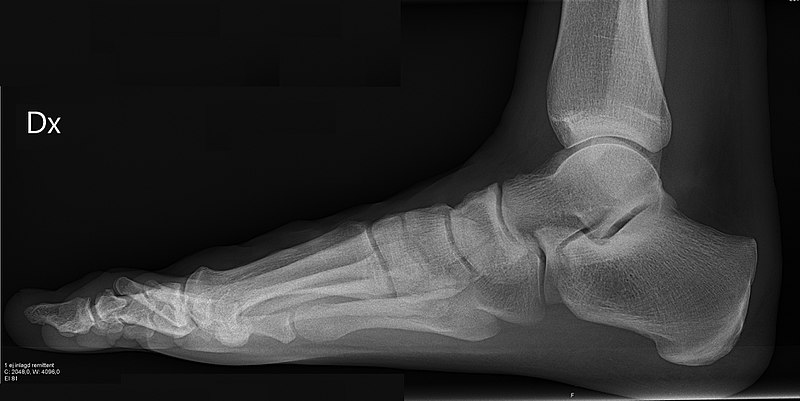Playlist
Show Playlist
Hide Playlist
Lines, Tubes and Cardiac Devices in Radiology
-
Slides Lines and Tubes.pdf
-
Download Lecture Overview
00:01 So another type of line is called a peripherally inserted central catheter or a PICC line. 00:07 This provides long term venous access for medication administration or blood draws but it's a smaller bore than a central line. 00:14 It's usually placed into the cephalic, basilic or brachial veins within the arm and the tip is advanced until it reaches the SVC. 00:21 These lines may thrombose because they have a very small lumen size, so that's important to keep in mind when you think about how long the patient will need the line in place. 00:31 The lines that are placed for a longer period of time tend to be the one that thrombose. 00:36 So a Swan-Ganz Catheter monitors pulmonary artery and right heart pressure. 00:44 It's placed into the subclavian or IJ veins just like a central line is and the tip is advanced to the proximal or left, proximal right or left pulmonary artery. 00:54 It should be approximately 2 cm away from the hilum and complications include pulmonary infraction from occlusion of the pulmonary artery by catheter. 01:03 It's not a very common complication but something to keep in mind. 01:06 So you can see here, the Swan-Ganz Catheter coming and then looping around ending in the expected location within the left pulmonary artery. 01:17 Chest tubes are placed to drain collections of air or fluid within the pleural space. 01:25 This is very commonly seen in patients that have a pneumothorax and they're a usually placed anterosuperiorly for the pneumothorax which tends to rise superior because of gravity. 01:35 For effusions they're usually placed posteroinferiorly because the fluid again because of gravity drifts down to the bottom of the lung. 01:42 Chest tubes have side holes which should remain within the thoracic cavity because if the side holes are out within the soft tissues, it can result in subcutaneous emphysema. 01:53 Complications of a chest tube include laceration of the intercostal artery which can cause bleeding, they can also cause laceration of the liver or spleen if they're placed too far inferiorly. 02:04 So let's talk a little bit about cardiac devices, this is an example of a pacemaker which is placed to regulate heart rhythm. 02:14 The generator is usually implanted subcutaneously within the chest wall. 02:18 So there can be different types of pacemaker, you can have a single lead pacemaker which has a single lead that's positioned in the apex of the right ventricle. 02:28 You can have a dual lead pacemaker which has one lead within the apex of the right ventricle and another within the right atrium. 02:34 Or you can have a triple lead pacemaker which has one lead in the apex of the right ventricle, one on the right atrium and one within the coronary sinus. 02:43 And these are usually paced placed by cardiologists and they determine which of these would work best for the patient. 02:49 So this is an example of a patient with the pacemaker, you can see the pacemaker battery, here, overlying the left hemithorax slightly embedded within the soft tissues here and then you can see the leads coming down here. 03:06 This is an example of what it would look like on the lateral view, you can see two leads coming down here on the lateral view. 03:14 This patient also has something else within the heart. 03:18 So do you know what that is? There are couple of round densities within the heart, you see them pretty well in the lateral view here. 03:27 So these are actually valve replacements and these are occasionally seen in patients as well. 03:32 So let's talk a little bit about a defibrillator and how it looks different from a pacemaker. 03:40 So defibrillators are used in the setting of a tachyarrhythmia. 03:43 You have one electrode within the SVC or brachiocephalic vein and possibly a second at the right ventricular apex. 03:51 The leads may fracture so this is important to look for when you're taking a look at the imaging of a defibrillator. 03:57 And you can see that the distal tip of the defibrillator is actually thicker than that of a pacemaker and that's really how you differentiate between the two. 04:05 So what is an intra-aortic balloon pump? It's actually a type of line that's placed that increases cardiac output and coronary artery flow. This is usually placed in the proximal descending aorta, distal to the left subclavian and the balloon inflates during diastole and deflates during systole. You only see a very small portion of it on a radiograph and this is what it looks like right here. 04:35 We don't actually see the balloon part but really just the part that's metallic. 04:39 Complications of these include occlusion of the great vessels if it's placed too proximally. 04:46 It could also cause showering of emboli during either placement or removal. 04:50 And it can occasionally cause aortic dissection or perforation. 04:55 Again, these are not very common complications but something to be aware of. 04:59 So we've gone over multiple different lines and tubes that can be found within a patient, usually when I take a look at the chest x-ray. 05:08 I start off by taking at the lines, taking a look at the lines and tubes kind of early on because you wanna make sure that they all look like that they're in good position, you wanna make sure that none of them are broken before you go on to taking a look at the rest of the film including the lungs and the mediastinum.
About the Lecture
The lecture Lines, Tubes and Cardiac Devices in Radiology by Hetal Verma, MD is from the course Thoracic Radiology.
Included Quiz Questions
What is the disadvantage of the PICC line?
- Thrombosis due to small lumen of the veins it is inserted into
- Higher chance of infection as it is placed in a cephalic vein.
- It cannot be used for a long time.
- Higher chance of infection as it advanced until the right ventricle.
- Rupture of the blood vessel with minimal trauma
Which of the following statements regarding the Swan-Ganz catheter is FALSE?
- The tip of the catheter should reach the level of the mid-right bronchus.
- It monitors pulmonary artery and right heart pressure.
- It is placed in the subclavian vein.
- Complications include pulmonary infarction.
- The tip of the catheter should be advanced to reach the proximal right or left pulmonary artery.
A 35-year-old male is brought to the emergency room after a road traffic accident. He cannot speak due to severe shortness of breath but nods when asked if he has pain. On auscultation, there is a decreased air entry to the right lung and hyper-resonance on percussion. What should be the position of the chest tube for pneumothorax?
- Anterosuperior
- Posteroinferior
- Lateral
- Anteroinferior
- Posterosuperior
The lead of a triple lead pacemaker is placed in the apex of the right ventricle, right atrium, and…?
- …coronary sinus.
- …AV node.
- …SA node.
- …left ventricle, anterior wall.
- …brachiocephalic vein.
Which statement regarding the intra-aortic balloon pump is NOT true?
- It decreases cardiac output and coronary artery flow.
- The balloon inflates in diastole and deflates in systole.
- It can occlude the great vessels if placed too proximally.
- It can lead to aortic dissection or perforation.
- It is usually placed in the descending aorta.
Customer reviews
5,0 of 5 stars
| 5 Stars |
|
5 |
| 4 Stars |
|
0 |
| 3 Stars |
|
0 |
| 2 Stars |
|
0 |
| 1 Star |
|
0 |




